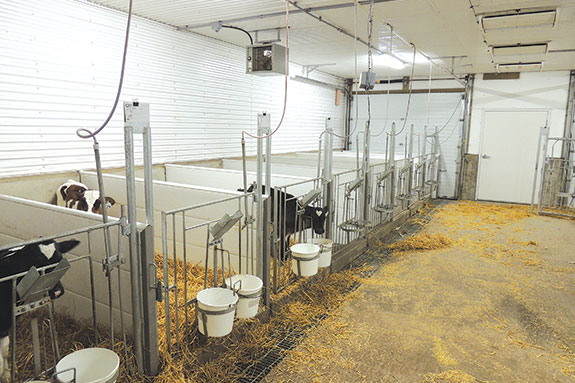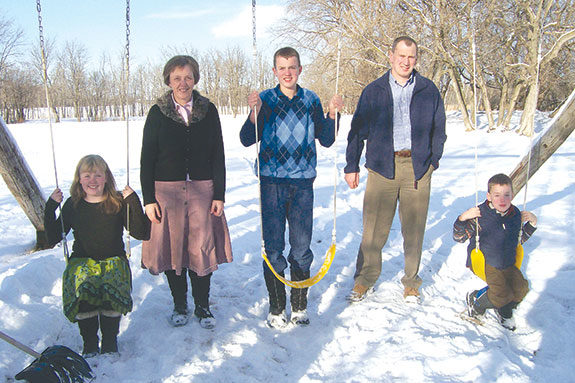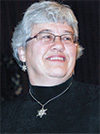Canada offered opportunities that were just not available at home.
Although leaving family was difficult, they have no regrets and have built a new life near the southeastern Manitoba village of La Broquiere.
The couple’s three children – James, 14, Laurel, 12, and Isaac, 7 – were born here and the family has developed many good friendships in their community.
They purchased a dairy farm, with 100 cows, and a barn that had been converted from a tiestall to a freestall operation. It came with a worn-out double-six milking parlour. It was labour intensive and high maintenance but it was a start for Leaford Holsteins.
By 2000, they were able to purchase a neighbouring farm, with another 50 cows. They erected a new freestall barn for 120 cows and replaced the worn-out parlour with a swing-20 parlour. This requires two people to keep up with the flow of cows at milking time.
The old hip roof barn was re-purposed again, this time as a calving facility, as finances did not allow them to do all they wanted to at that time.
However, they still had problems, as the old barn was very labour-intensive for cleaning and ventilation wasn’t satisfactory.
Albert toured other facilities and consulted with various suppliers as he planned his next expansion. In 2011 he was ready – a new barn measuring 100 feet by 120 feet was added to the existing freestall barn.
This was also a freestall facility but with larger stalls, measuring 53 inches wide by seven-and-a-half feet long. The larger space allows more comfort and greater lunge space.
He chose rubber matting for this barn – experience with mattresses in his first barn convinced him that mats were easier to clean and maintain.
Flax shives are used for bedding. Albert finds that these leftovers from flax straw have good absorbency and mix well with liquid manure. Scrapers keep the alleyways free of manure buildup and grooved floors help prevent injuries from cows slipping.

This barn also allows for new calving pens on straw packs.
These pens are much larger and cows can stay there for about a week following calving, longer if needed.
Each pen is equipped with a headlock gate if needed to help in handling cows. Gates are removable for ease of cleaning.
Ventilation is accomplished by use of 22 fans, creating tunnel ventilation at four to five miles per hour. “If standing by the intake, hold onto your hat,” Albert quips.
He states that even in the hot weather last summer, production did not falter. The herd kept up to quota and better. The moving air also keeps flies from bothering the cows.
In addition to the new freestall barn, the old hip roof barn was taken down and a new stand-alone calf barn was erected.
This contains two nursery rooms, each with 16 individual stalls – eight on each side. This is a heated, all-in, all-out system. There is a self-contained hot water room, which drains to a central pit, along with liquid wastes from the calf barn.
Feeding is done with a pail system using only milk replacer. For ease of cleaning, dividers are removable and rooms are power-washed after each group.
Once well started, at 6 to 8 weeks, calves are combined in small groups in a loose housing area with three pens on each side. Here they are introduced to a TMR . Weaning occurs at 10 to 12 weeks.
Heifers move to a cold barn between 6 and 8 months and, at breeding age, are moved to the second farm where they have access to an outdoor exercise area. They return to the home facility when close to calving at 22 to 26 months.
Albert expects to have healthier calves with his new way of handling youngsters, which in turn will help tighten up his age at first calving. The new barns came into use early in 2012.
The herd now consists of 175 milking animals and about the same number of dry cows, calves and heifers. Most are Holsteins, with about 80 percent registered stock.
There are also some Jerseys and crossbred cows, but Albert is working towards having an all-registered herd in the future.
Feeding is a TMR system with drive-through feed alleys. They grow their own feed, purchasing only protein and supplements. The farm has grown to include 1,000 acres with additional rented land.
Albert does not utilize pasture; he has found he has better results when cattle are kept indoors, where they don’t have to deal with the wet weather, mud, flies and mosquitoes that seem to abound in the area.
The Wolfes employ two full-time employees and one part-time employee to help run the business. Employees and family take alternate three-day weekends, giving everyone time off on a regular basis.
Alyson does the bookkeeping and helps in the dairy on weekends, but is otherwise occupied during the week with home-schooling the children and chauffeuring them to various activities.
James is already quite involved with the farm; Laurel enjoys visits from the veterinarian and is musically inclined. Isaac is an enthusiastic reader and has been learning about the Titanic recently – Robert Ballard is his current hero.
The family enjoys entertaining and meeting new people and is involved with their church. Albert also enjoys snowmobiling when he gets a chance.
When asked about his biggest challenges to date, Albert replies, “In the years 2003 to 2006 seeding, harvesting and making hay were very difficult due to heavy rainfall and flooding in this area.
This, combined with a significant herd health issue and low prices for animals due to BSE, was probably the biggest challenge we have faced ... having come through such, we are thankful to God that we are still in a position to farm along with our children.” PD
PHOTOS
TOP: In the 16 years since they moved from Ireland, Albert and Alyson Wolfe have added to their farm and family, making themselves at home in Canada’s rural countryside. The Wolfe family includes, left to right, Laurel, Alyson, James, Albert and Isaac.
BOTTOM: After years of making due in a retrofitted hip roof barn, the Wolfes built a new calf facility. This building contains two nursery rooms, each with 16 individual stalls – eight on each side. It is a heated, all-in, all-out system. Photos courtesy of Albert and Alyson Wolfe.
Alice Guthrie is a freelance writer from Hagersville, Ontario.










